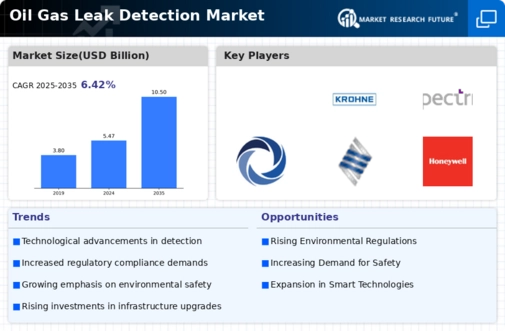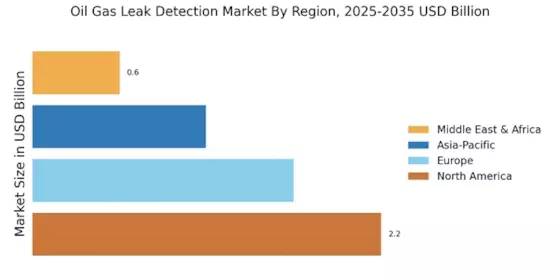Rising Environmental Concerns
The Oil Gas Leak Detection Market is increasingly shaped by rising environmental concerns and the need for sustainable practices. As awareness of climate change and environmental degradation grows, stakeholders are demanding more effective leak detection solutions to mitigate risks associated with oil and gas operations. This shift is prompting companies to adopt advanced technologies that not only comply with regulations but also demonstrate a commitment to environmental stewardship. The market is likely to see a surge in demand for eco-friendly detection methods, which could lead to a valuation exceeding USD 4 billion by 2027, as organizations strive to align with sustainability goals.
Regulatory Compliance and Safety Standards
The Oil Gas Leak Detection Market is significantly influenced by stringent regulatory compliance and safety standards imposed by various governmental bodies. These regulations mandate the implementation of effective leak detection systems to prevent environmental disasters and ensure public safety. Companies are compelled to invest in advanced detection technologies to meet these requirements, which drives market growth. For instance, regulations in regions such as North America and Europe have led to increased adoption of sophisticated leak detection systems. The market is projected to witness a compound annual growth rate of approximately 7% as organizations prioritize compliance and safety in their operations.
Growing Demand for Automation in Operations
The Oil Gas Leak Detection Market is witnessing a growing demand for automation in operations, which is reshaping the landscape of leak detection. Automation technologies, including remote monitoring and automated reporting systems, are being integrated into existing operations to enhance efficiency and reduce human error. This trend is particularly relevant as companies seek to optimize their processes and minimize operational costs. The adoption of automated leak detection systems is expected to increase, potentially leading to a market growth rate of around 6% annually. As organizations embrace automation, the need for sophisticated detection solutions will likely rise, further propelling the market forward.
Technological Advancements in Detection Methods
The Oil Gas Leak Detection Market is experiencing a surge in technological advancements that enhance detection capabilities. Innovations such as fiber optic sensors, drones, and advanced algorithms for data analysis are becoming increasingly prevalent. These technologies allow for real-time monitoring and rapid response to potential leaks, thereby minimizing environmental impact and financial losses. The integration of artificial intelligence and machine learning into detection systems is also noteworthy, as it improves accuracy and reduces false positives. As companies seek to modernize their operations, the demand for these advanced detection technologies is expected to grow, potentially leading to a market expansion valued at over USD 3 billion by 2026.
Increased Investment in Oil and Gas Infrastructure
The Oil Gas Leak Detection Market is benefiting from increased investment in oil and gas infrastructure, particularly in emerging markets. As countries expand their energy production capabilities, the need for reliable leak detection systems becomes paramount. Investments in pipelines, refineries, and storage facilities necessitate the implementation of advanced detection technologies to ensure operational safety and efficiency. This trend is expected to drive market growth, with projections indicating a potential market size of USD 5 billion by 2028. The focus on infrastructure development is likely to create opportunities for companies specializing in leak detection solutions.

















Leave a Comment